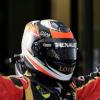As has been stated here previously, there are any number of "one design" categories around the world to satisfy spectators who want to see racing based on driver skill alone (of course car setup and preparation remain a factor). Formula 1 needs to remain a class where technological innovation can flourish. I believe the rules should be as open as possible with annual tightening of a couple of key specifications to maintain safety levels as technology raises the performance potential of the cars. Having said that, I am not against limiting technologies that have little or no road car relevance eg aero.
This line of argument is not clear to me. Without parity of machines there can be no good racing, and by definition technological advancement occurs in fits and starts, which results in a continuous lack of parity among machinery and an increased likelikhood of boring racing. Only when the machinery is allowed to mature, or to at least develop at a measured pace, does technological advancement cease to be the domain of the few machines on the grid with the resources to exploit the technology. The longer the ruleset stays constant, regardless of the content, the closer to "spec" the machinery becomes, with no machine having a clear advantage. The explicit limiting of certain technologies only hastens this condition of evolved parity. This of course is a horrible thought for people that would rather see one machine way out in front because one team has the newest technological advancement and the resources to exploit it, but racing is a business, and one machine or another consistently way out in front is bad for the business of racing.
Rules exist to force parity, with the intent of indirect budgetary control, and of course exciting racing. Rules that legislate new technologies or deviations from the existing norm are not specifically anti-technology or anti-ingenuity, they are aimed at forcing parity. The disconnect between forced parity and racing with regards to new automotive technology is that most new technologies related to mainstream, practical, automotive development are aimed at reducing the negative effect of the most poorly developed and inconsistent feature of any vehicle, and that is the human control system. Which is EXCELLENT for parity, but TERRIBLE for exciting racing.
Traction/stability control, control by wire, adaptive/active suspension, ABS, almost all of the mentioned "trickle down technologies" which actually benefit the general public were designed specifically to take control away from the driver, or enhance the ability of the driver beyond what would be physically possible for them to do without those new technologies. Are the techno-fetishists here advocating that F1 adopt the new technologies related to actual automotive development now like adaptive cruise control, automated path following, lane keeping assist, collision avoidance and the like which are rightfully being developed because of their high value to actual passenger car use? At what point do you cry uncle in the quest for "new" and "innovative" technologies to be implemented in racing?
There certainly are venues for spec racing, but right back at you, there are certainly more appropriate venues for the advancement of technology as it relates to practical use than racing. Certainly the concept of high downforce aerodynamics is neither new nor innovative, and certainly has no relevance to any form of ground based practical transport currently or in development.
One of the first things I do in any "fun" car is find the button or start sequence to disable or minimize the traction/stability/yaw control, thereby negating decades worth of trickle down racing technology. And I fear the (inevitable) day that I no longer do this. But perhaps that is where we fundamentally differ...















